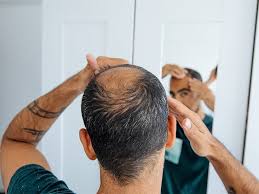Hair loss is a common concern that affects millions of people worldwide, leading to a search for effective solutions. While there are numerous products and treatments available, the use of FGF9 (Fibroblast Growth Factor 9) in combination with growth factors has emerged as a promising strategy for hair regeneration. Applying growth factors to the scalp may be the most efficacious way to stimulate FGF9 and promote hair growth.
Understanding FGF9 and Its Role in Hair Regeneration
FGF9 is a member of the fibroblast growth factor family, which plays a crucial role in tissue regeneration, wound healing, and the development of various organs, including hair follicles. In recent years, researchers have discovered that FGF9 is particularly important in the hair follicle growth cycle. It is involved in both the development of hair follicles during embryogenesis and their regeneration in adulthood.
FGF9 has been proven to simulate additional hair follicles in mice (Gay D, Kwon O, Zhang Z, et al. Fgf9 from dermal γδ T cells induces hair follicle neogenesis after wounding. Nat Med. 2013;19(7):916-923.)
Hair growth follows a cycle that includes growth (anagen), regression (catagen), and rest (telogen) phases. FGF9 is essential for maintaining the anagen phase, where active hair growth occurs. When FGF9 levels are insufficient, the hair follicles enter the catagen phase prematurely, leading to hair thinning and eventual hair loss.
Why Growth Factors
At this time there is no way to directly apply or inject human FGF9 into the scalp. The most effective way to stimulate FGF9 currently is the use of growth factors.
Growth factors are naturally occurring proteins that play a vital role in cell proliferation, tissue repair, and regeneration. When it comes to hair regeneration, growth factors can stimulate the activity of hair follicles and promote hair growth. Some common growth factors involved in this process include:
1. Vascular Endothelial Growth Factor (VEGF): Promotes blood vessel formation, ensuring that hair follicles receive an adequate blood supply for nourishment.
2. Platelet-Derived Growth Factor (PDGF): Supports cell proliferation and tissue repair, aiding in the regeneration of damaged hair follicles.
3. Insulin-Like Growth Factor-1 (IGF-1): Encourages cell growth and division, contributing to the growth of new hair.
4. Epidermal Growth Factor (EGF): Stimulates cell turnover in the hair follicles and helps maintain their health.
How Growth Factors Stimulate FGF9:
1. Targeted Approach: When growth factors are applied topically to the scalp, they can directly reach the hair follicles and surrounding tissues, where FGF9 activity is crucial. This targeted approach ensures that the growth factors have the greatest impact on hair regeneration.
2. Synergistic Effect: The combination of various growth factors, such as VEGF, PDGF, IGF-1, and EGF, can work synergistically to stimulate FGF9 production and promote a healthy hair growth cycle. Each growth factor plays a unique role in supporting the regeneration process.
3. Minimal Side Effects: Topical application of growth factors is generally well-tolerated and has minimal side effects compared to some other hair restoration treatments.
Growth factors offer a promising avenue for those seeking effective solutions for hair regeneration. By understanding the role of FGF9 in the hair growth cycle and harnessing the power of growth factors through topical application, individuals experiencing hair loss may find a more efficacious and natural way to promote hair growth and regain their confidence. As research in this field continues to evolve, we can look forward to even more advanced and effective treatments for hair regeneration in the future.
Our Derive Growth Factor Hair System is able to penetrate the scalp with the highest quality growth factors with no discomfort.

